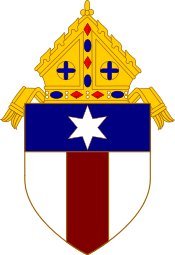Lourdes Central Catholic High School (Nebraska)
| Lourdes Central Catholic High School | |
|---|---|
| Address | |
|
412 Second Avenue Nebraska City, Nebraska, (Otoe County) 68410 United States | |
| Coordinates | 40°40′43″N 95°51′1″W / 40.67861°N 95.85028°WCoordinates: 40°40′43″N 95°51′1″W / 40.67861°N 95.85028°W |
| Information | |
| Type | Private, Coeducational |
| Motto | "Tradition of Excellence" |
| Religious affiliation(s) | Roman Catholic |
| Superintendent | Fr. Mark Cyza |
| Principal | Curt Feilmeier |
| Grades | Pre-Kindergarten–12 |
| Student to teacher ratio | 1:20 |
| Hours in school day | 7 1/2 |
| Color(s) | Royal Blue and White |
| Song | Notre Dame Victory March |
| Athletics | football, volleyball, men's and women's basketball, and track |
| Athletics conference | Pioneer Conference |
| Team name | Knights |
| Tuition | $850.00-$2000.00 |
| Athletic Director | Joe Tynon |
| Website | School Website |
Lourdes Central Catholic High School is a private, Roman Catholic high school in Nebraska City, Nebraska. It is located in the Roman Catholic Diocese of Lincoln. It is also known as Our Lady of Lourdes Central Catholic Schools. The Lourdes Central Catholic School's "tradition of excellence" began over a century ago. In 1861, Saint Benedict's Parish, with the assistance of the Benedictine Sisters from Pennsylvania, founded a parochial school known as Saint Benedict's School. As the need for Catholic education grew in Nebraska City, Saint Benedict's School was joined in 1865 by Annunciation Academy, an all girls school, and in 1880 by Saint Mary's School Due to decrease in enrollment, Saint Mary's School closed in 1891, and the building was sold to the Nebraska City Public Library Committee. In 1908, Annunciation Academy was also closed due to a lack of funds to repair the deteriorating building. Over the course of several years, numerous attempts were made to reopen Saint Mary's School. Those attempts proved futile until the Bernadine Madames of Ollingies, Belgium, offered to establish a new school and convent in Nebraska City. In 1909, Saint Bernard's Academy was founded in the former home of Judge William Hayward. Saint Bernard's Academy offered classes for boys and girls and provided a boarding school for the girls.
Due to a change in the state law which disqualified aliens from teaching in public and private schools, the Bernadine madames left Nebraska City in 1920. The sisters were replaced at Saint Bernard's Academy by the Ursuline Sisters of Kentucky that same year. In 1927, the Ursuline Sisters assumed responsibility for Saint Benedict's School as well. A new Saint Benedict's School building was erected by the sisters and the members of Saint Benedict's Parish in 1951. The structure now houses the present Lourdes primary grades.
An ever increasing student enrollment at Saint Bernard's Academy created a need for a central high school, which would include students from Saint Mary's and Saint Benedict's in Nebraska City, Saint Bernard's in Julian, Saint Paul's in Dunbar and Saint Joseph's in Paul. The central high school was constructed at its present location on Second Avenue and was named the Lourdes Central Catholic School. Shortly thereafter, the high school was joined to an elementary school named Saint Mary's School.
In 1963, the two parishes in Nebraska City consolidated their elementary schools, with Saint Mary's having grades one through five and Saint Benedict's handling grades six through eight. In 1966, Lourdes became a junior-senior high school with grades seven through twelve, and in 1970, grades one through three were moved to the Saint Benedict's School building, while the upper grades moved to the Saint Mary's School building.
Today, the Lourdes Central Catholic Schools include grades kindergarten through twelve and are supported by St. Mary's and St. Benedict's Parishes in Nebraska City, St. Joseph's in Paul, St. Bernard's in Julian, St. Paulinus' in Syracuse, St. Clara's in Peru, St. Joseph's in Auburn, Holy Trinity in Avoca, and Holy Spirit in Plattsmouth. Lourdes is a class D-1 school according to the Nebraska Scholastic Activities Association (NSAA). Its students are mostly from the nine supporting Catholic parishes, but also from other faith traditions.
